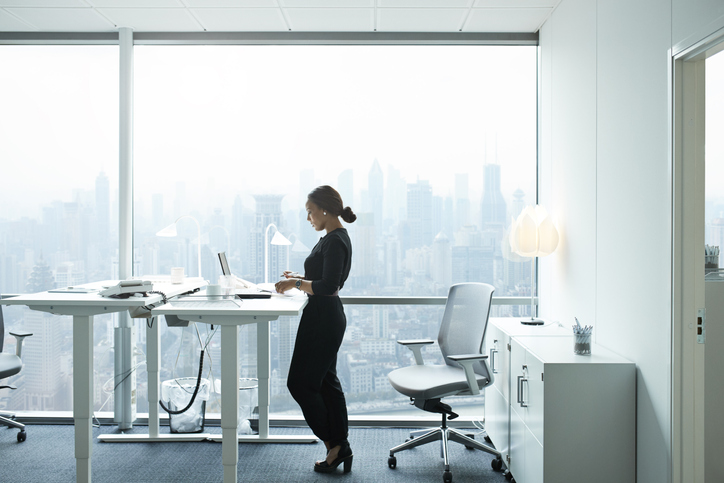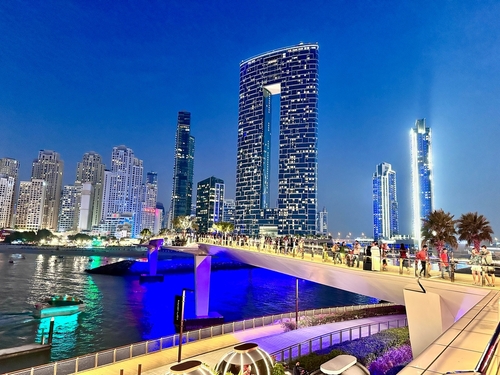Are Standing Desks Really Better for Your Back?
Those prone to pain might get more relief if they invest in these accessories—from anti-fatigue mats to a posture monitor.
Doctors, no fans of sedentary lifestyles, rarely encourage anyone—especially those with back pain—to spend all day sitting. A standing desk can help avert aching muscles if you use it correctly, get off your feet and move at regular intervals and—here’s where we come in—consider investing in the right ergonomic accessories. If you insist on slouching in high heels on a concrete floor for hours, we can’t help you.
A standing desk alone is a good start. In 2019, researchers at the University of Pittsburgh examined data from 53 independent, peer-reviewed studies and concluded that workers can experience a decrease in lower-back pain when using a standing desk. A year earlier, Dr. Elizabeth Garland, professor at Icahn School of Medicine at Mount Sinai in New York, and her team published the results of a yearlong evaluation of users at standing and traditional desks. “The people who used the standing desk more had less back pain, more energy and took on more physical activity outside of work,” she said.
Jonathan Perez, a territory manager for a sporting goods supplier in Port St. Lucie, Fla., went further. Mr. Perez has mild scoliosis and bought a standing desk hoping it would help. Two years on, the pain persists, but a new routine has made it far more tolerable. “I bought an anti-fatigue mat, got my foot scanned at a running store to get sized for shoes and consulted a yoga instructor about core stretches,” he said. Those moves, along with a commitment to alternating between standing, sitting and using a foam roller on the floor to massage his back, have brought relief.
Lauren Scott, a digital marketing coordinator in Hawthorne, N.J., said using a standing desk consistently for five years eventually helped resolve sciatica pain. But when she stands, Ms. Scott doesn’t merely stay erect. A barefoot enthusiast, she plants her feet on a foam mat for comfort and uses a lacrosse ball and knobby rock mat to stretch them.
Without an ergonomic plan, standing can become uncomfortable, making it easy to default back to a chair. Some basic tips: Keep the desk’s top at elbow height so your fingers hang down to meet the keyboard. Stand straight so your neck is tall and shoulders are relaxed. Elevate the monitor so the top third of the screen is at eye level and close enough that you needn’t lean forward to read. As for how to split up your day, Dr. Garland likes the “20-8-2 rule” where you break 30-minute blocks up into 20 minutes for sitting, 8 for standing and 2 for walking.
But if you really want to ensure you’re standing up to back pain, consider these accessories.
Five Accessories That Can Take a Desk From Helpful to Really Helpful
Stand On Solid Principles
An anti-fatigue mat will take the sting out of standing on hard surfaces like concrete, hardwood and tile. While most mats look like the slabs of rubber or polyurethane foam that line cooks use, the Fluidstance Springboard looks at home in an office. The flexible plywood top, along with a 1-inch-thick felt base, provides enough cushion and bounce to reduce fatigue and encourage you to shift weight. $235, FluidStance.com
Mind the Slouch
If reminding yourself not to slouch feels like a full-time job, let the Upright Go S do it for you. Stick the tracker to the skin between your shoulder blades, or drape it over a shirt using the Necklace accessory ($20). When it detects hunching, a gentle vibration prompts you to straighten up. To avoid falling into that “evil-witch position,” consider an elevated monitor, said Dr. Charla R. Fischer, an orthopedic surgeon at NYU Langone Spine Center. $83UprightPose.com
Bare Your Tensions
A mat alternative: The sloped Sky Solutions Genius Mat can massage and stretch bare feet, thanks to a rollerball and acupressure-like nubs. “What we’re learning is the more time we can spend out of shoes the better,” said Dr. Brian Meenan, a chiropractor in Pittsburgh, of foot muscles that can go underdeveloped in shoes. If you go this route, gradually work up to spending about half your day sans shoes. $111, SkyMats.com
Look Up
You could pile books under a monitor to elevate it, or use the highly adjustable Uplift Desk Enfield Single Monitor Arm and reclaim desk space. The arm clamps to, or bolts through, the desktop, neatly corralling wires, and lets you tweak the screen’s position as you go from sitting to standing. (Laptop users need an arm designed to lift the computer to eye level, and should pair it with a wireless keyboard and mouse.) $165, UpliftDesk.com
Invest in Smarter Sneakers
The best footwear for standing-desk adoptees is a sneaker that provides more cushion and support than a minimalist running shoe but not as much as a plush walking sneaker. Chiropractor Dr. Alex Tauberg, also based in Pittsburgh, often recommends a trail hiking or trail running shoe. “They have an athletic styling, a decent amount of cushion, and they’re supportive,” he said. The Altra Superior 5 is a “zero drop” shoe — the foot rests flat on the ground without the lifted heel — with a wide toe box that allows your dogs to splay out without bunching.
Reprinted by permission of The Wall Street Journal, Copyright 2021 Dow Jones & Company. Inc. All Rights Reserved Worldwide. Original date of publication: February 9, 2022.
 Copyright 2020, Dow Jones & Company, Inc. All Rights Reserved Worldwide. LEARN MORE
Copyright 2020, Dow Jones & Company, Inc. All Rights Reserved Worldwide. LEARN MORE
This stylish family home combines a classic palette and finishes with a flexible floorplan
Just 55 minutes from Sydney, make this your creative getaway located in the majestic Hawkesbury region.
As Paris makes its final preparations for the Olympic games, its residents are busy with their own—packing their suitcases, confirming their reservations, and getting out of town.
Worried about the hordes of crowds and overall chaos the Olympics could bring, Parisians are fleeing the city in droves and inundating resort cities around the country. Hotels and holiday rentals in some of France’s most popular vacation destinations—from the French Riviera in the south to the beaches of Normandy in the north—say they are expecting massive crowds this year in advance of the Olympics. The games will run from July 26-Aug. 1.
“It’s already a major holiday season for us, and beyond that, we have the Olympics,” says Stéphane Personeni, general manager of the Lily of the Valley hotel in Saint Tropez. “People began booking early this year.”
Personeni’s hotel typically has no issues filling its rooms each summer—by May of each year, the luxury hotel typically finds itself completely booked out for the months of July and August. But this year, the 53-room hotel began filling up for summer reservations in February.
“We told our regular guests that everything—hotels, apartments, villas—are going to be hard to find this summer,” Personeni says. His neighbours around Saint Tropez say they’re similarly booked up.
As of March, the online marketplace Gens de Confiance (“Trusted People”), saw a 50% increase in reservations from Parisians seeking vacation rentals outside the capital during the Olympics.
Already, August is a popular vacation time for the French. With a minimum of five weeks of vacation mandated by law, many decide to take the entire month off, renting out villas in beachside destinations for longer periods.
But beyond the typical August travel, the Olympics are having a real impact, says Bertille Marchal, a spokesperson for Gens de Confiance.
“We’ve seen nearly three times more reservations for the dates of the Olympics than the following two weeks,” Marchal says. “The increase is definitely linked to the Olympic Games.”

Getty Images
According to the site, the most sought-out vacation destinations are Morbihan and Loire-Atlantique, a seaside region in the northwest; le Var, a coastal area within the southeast of France along the Côte d’Azur; and the island of Corsica in the Mediterranean.
Meanwhile, the Olympics haven’t necessarily been a boon to foreign tourism in the country. Many tourists who might have otherwise come to France are avoiding it this year in favour of other European capitals. In Paris, demand for stays at high-end hotels has collapsed, with bookings down 50% in July compared to last year, according to UMIH Prestige, which represents hotels charging at least €800 ($865) a night for rooms.
Earlier this year, high-end restaurants and concierges said the Olympics might even be an opportunity to score a hard-get-seat at the city’s fine dining.
In the Occitanie region in southwest France, the overall number of reservations this summer hasn’t changed much from last year, says Vincent Gare, president of the regional tourism committee there.
“But looking further at the numbers, we do see an increase in the clientele coming from the Paris region,” Gare told Le Figaro, noting that the increase in reservations has fallen directly on the dates of the Olympic games.
Michel Barré, a retiree living in Paris’s Le Marais neighbourhood, is one of those opting for the beach rather than the opening ceremony. In January, he booked a stay in Normandy for two weeks.
“Even though it’s a major European capital, Paris is still a small city—it’s a massive effort to host all of these events,” Barré says. “The Olympics are going to be a mess.”
More than anything, he just wants some calm after an event-filled summer in Paris, which just before the Olympics experienced the drama of a snap election called by Macron.
“It’s been a hectic summer here,” he says.

AFP via Getty Images
Parisians—Barré included—feel that the city, by over-catering to its tourists, is driving out many residents.
Parts of the Seine—usually one of the most popular summertime hangout spots —have been closed off for weeks as the city installs bleachers and Olympics signage. In certain neighbourhoods, residents will need to scan a QR code with police to access their own apartments. And from the Olympics to Sept. 8, Paris is nearly doubling the price of transit tickets from €2.15 to €4 per ride.
The city’s clear willingness to capitalise on its tourists has motivated some residents to do the same. In March, the number of active Airbnb listings in Paris reached an all-time high as hosts rushed to list their apartments. Listings grew 40% from the same time last year, according to the company.
With their regular clients taking off, Parisian restaurants and merchants are complaining that business is down.
“Are there any Parisians left in Paris?” Alaine Fontaine, president of the restaurant industry association, told the radio station Franceinfo on Sunday. “For the last three weeks, there haven’t been any here.”
Still, for all the talk of those leaving, there are plenty who have decided to stick around.
Jay Swanson, an American expat and YouTuber, can’t imagine leaving during the Olympics—he secured his tickets to see ping pong and volleyball last year. He’s also less concerned about the crowds and road closures than others, having just put together a series of videos explaining how to navigate Paris during the games.
“It’s been 100 years since the Games came to Paris; when else will we get a chance to host the world like this?” Swanson says. “So many Parisians are leaving and tourism is down, so not only will it be quiet but the only people left will be here for a party.”
This stylish family home combines a classic palette and finishes with a flexible floorplan
Just 55 minutes from Sydney, make this your creative getaway located in the majestic Hawkesbury region.






















